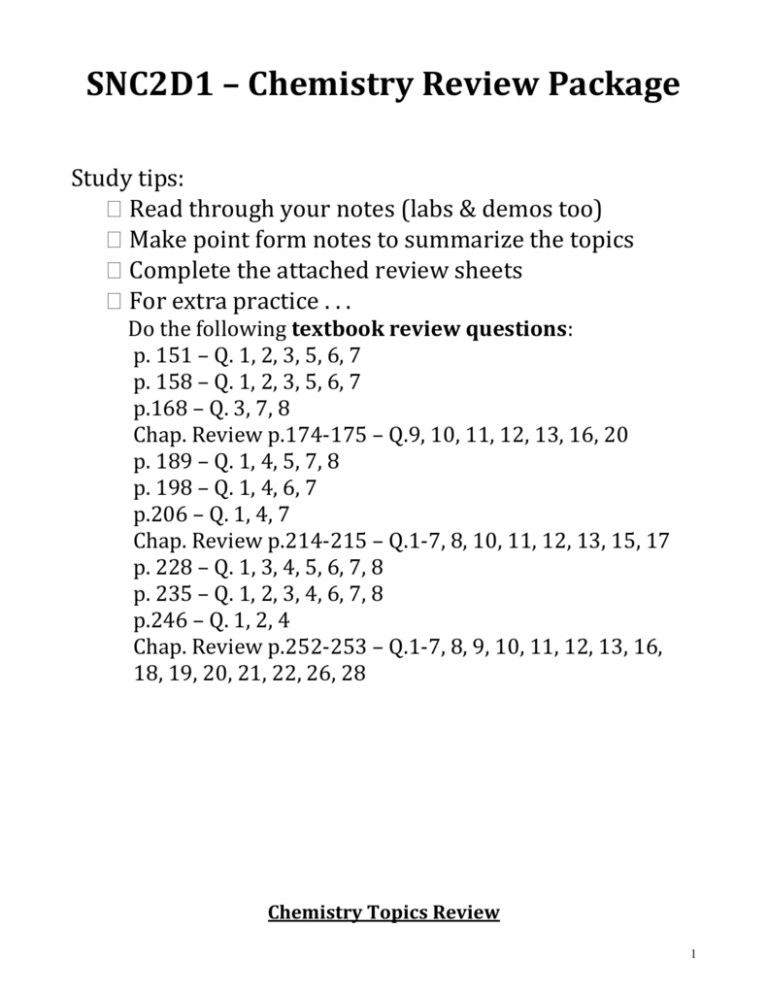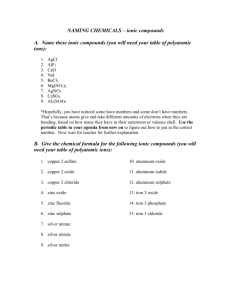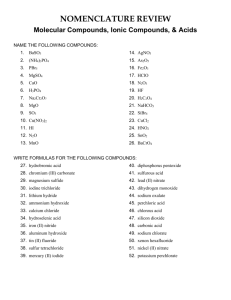Review Package - misshoughton.net
advertisement

SNC2D1 – Chemistry Review Package Study tips: Read through your notes (labs & demos too) Make point form notes to summarize the topics Complete the attached review sheets For extra practice . . . Do the following textbook review questions: p. 151 – Q. 1, 2, 3, 5, 6, 7 p. 158 – Q. 1, 2, 3, 5, 6, 7 p.168 – Q. 3, 7, 8 Chap. Review p.174-175 – Q.9, 10, 11, 12, 13, 16, 20 p. 189 – Q. 1, 4, 5, 7, 8 p. 198 – Q. 1, 4, 6, 7 p.206 – Q. 1, 4, 7 Chap. Review p.214-215 – Q.1-7, 8, 10, 11, 12, 13, 15, 17 p. 228 – Q. 1, 3, 4, 5, 6, 7, 8 p. 235 – Q. 1, 2, 3, 4, 6, 7, 8 p.246 – Q. 1, 2, 4 Chap. Review p.252-253 – Q.1-7, 8, 9, 10, 11, 12, 13, 16, 18, 19, 20, 21, 22, 26, 28 Chemistry Topics Review 1 1. Safety Symbols 2. Matter, Physical and chemical properties/changes 3. The Periodic Table – Classifications Metals/non-metals/metalloids Groups & periods Name of groups 4. Drawing Bohr-Rutherford Diagrams & Lewis Dot Structures Atoms/ions 5. Ionic Compounds (Textbook p. 139-146; 148-149) Terminology (ion, cation, anion, ionic charge/combining capacity, valence electron, stable octet, polyatomic ion, binary compound, ternary compound, ionic bond) Draw Bohr-Rutherford diagrams/Lewis Dot structures to show the formation of ionic compounds Naming & writing formula o binary ionic compounds o ionic compounds with polyatomic ions 6. Molecular Compounds (Textbook p. 152-158) Terminology (covalent bond, molecule, binary covalent compound) Draw Bohr-Rutherford diagrams/Lewis Dot structures to show the formation of molecular compounds Diatomic molecules (H2, N2, O2, Cl2, Br2, I2, and F2) Naming & writing formula - binary molecular compounds 7. Conservation of Mass & Chemical Equations (Textbook p. 159-168) Terminology (reactant, product, chemical reaction, chemical equation, coefficient) Law of Conservation of Mass Writing word equations, skeleton equations, balanced chemical equations 8. Classifying chemical Reactions (Textbook p. 179-198) Synthesis, Decomposition, Single displacement, Double displacement Combustion, Acid-base reaction Predicting products for the different types of reactions 9. Acids and Bases (Textbook p. 179-234; 236-245) Terminology (acid, base, ionization, dissociation, pH scale, neutralization) Naming and writing formula- Binary acids, Oxyacids pH scale Differences in pH values pH indicators Reactions of acids and bases - neutralization Chemistry Unit Review 2 1) What are the four clues of a chemical change? a) b) c) d) 2) Elements with similar properties are grouped into ____________________ called groups. Complete the following chart for each group. Group Location in periodic table Number of valence electrons Type of compound usually formed Halogens Noble gases Alkali metals Alkaline earth metals 3) Where are the non-metals and metals located in the periodic table? 4) Complete the following chart, using your periodic table to help you. # of Symbol Element name Atomic Atomic # of neutrons number mass protons Calcium # of electrons Electron configuration Sulphur Carbon Fluorine Sodium Helium Aluminum phosphorus 5) A(n) ______________________ is a positively charged ion formed by ___________________ electrons. A(n) _____________________ is a negatively charged ion formed by ___________________ electrons. 6) Draw a Bohr-Rutherford diagram for the atom of the following 3 elements: Mg P Ne 3 7) Draw a Bohr-Rutherford/Lewis diagram for the stable ions formed by each of the following atom: a) State the number of electrons gained or lost to form each ion. b) State the ionic charge on each of the ions. c) Name the noble gas that is isoelectric with each of the stable ions. Ca F K 8) For each of the following: (i) Classifying the type of bond that will form between the two elements as ionic or covalent. (ii) Use Bohr-Rutherford/Lewis diagrams to show how electrons are shared or transferred to form the bonds. Show resulting charges for ionic binding. (iii) Write the chemical formula. Calcium combines with fluorine Nitrogen combines with hydrogen 9) Complete the following chart: Type of bond Strategy for getting stable octet Types of elements involved Type of particles formed Ionic Molecular 10) Show the bonding for the following compounds: Compound Formula Type of Compound Lewis Dot Diagram 4 (Ionic or Molecular) (Show sharing or Transfer) CaCl2 H2O Al3P3 NH3 11) Write the chemical formulas for the following compounds: a) Sodium iodide b) Carbon monoxide c) Nitrogen triiodide d) Hydrochloric acid e) Sodium phosphate f) Nitrogen gas g) Magnesium oxide h) Phosphoric acid i) Potassium chlorate j) Beryllium nitrate k) Sulphuric acid l) Aluminum sulphide m)Hydrofluoric acid n) Magnesium carbonate o) Nitric acid p) Nitrogen and hydrogen q) Phosphorus and chlorine r) Sulphur and bromine s) Oxygen and fluorine t) Carbon and chlorine 12) Write the names for the following compounds: a) KCl 5 b) Al2(CO3)3 c) CBr4 d) Na3P e) SiCl4 f) NI3 g) HF (aq) h) K2CO3 i) KOH (aq) j) Na2SO4 k) H3PO4 (aq) l) SCl2 m)CCl4 n) H2SO4 (aq) o) NH4OH (aq) p) I2 q) CaF2 r) NH3 s) HNO3 (aq) t) CH4 u) OF2 v) Ca(OH)2 (aq) w) CaCO3 x) H2 y) RaI2 13) There are different types of compounds that are formed when atoms bond together. Complete the following chart to show the difference between these types. Characteristics Ionic Compound Molecular Compound Types of atoms involved Types of bond (ionic or covalent) Electrons (shared or transferred) Dissolve in water (yes or no) Conducts electricity Example: 14) Some elements exist in the form of diatomic molecules. What are these elements? 15) Vinegar is a compound. The chemical formula for vinegar is H3C2O2H 6 Type of elements present Number of atoms of each element 16) a) State the law of conservation of mass. b) What are the implications of this law during a chemical reaction? c) What does this law force us to have to do to our equations when we write them? 17) Examine the following word equation: Propane + oxygen → carbon dioxide + water a) List all reactants in this reaction. b) List all the products in this reaction. 18) The products of neutralization reactions are always __________________ and _____________________. Predict the products and balance the equations. a) ____NaOH (aq) + ____HCl (aq) → b) ____Mg(OH)2 (aq) + ____H2SO4 (aq) → c) ____Al(OH)3 (aq) + ____H2S (aq) → d) ____Ca(OH)2 (aq) + ____H3P (aq) → e) ___H2SO4 (aq) + ___NaOH (aq) → 7 19) For each of the following word equations, write the balanced chemical equation (with states) and classify the reaction. a) Calcium metal reacts with hydrobromic acid to form aqueous calcium bromide and hydrogen gas. b) Solid aluminum oxide is formed when aluminum metal reacts with oxygen gas. c) Sodium metal reacts with aqueous calcium oxide to produce aqueous sodium oxide and calcium metal. d) Nitrogen gas and liquid iodine are formed from nitrogen triiodide gas. e) Butane (C4H10) gas reacts with oxygen gas to produce liquid water and carbon dioxide gas. 20) Write a word equation to represent combustion of propane, a fuel used in stoves and home heating. Then write a balanced chemical equation for this reaction. 21) Classify each of the following reactions, and write skeleton and balanced equations. a) gallium + hydrochloric acid → hydrogen + gallium chloride b) Calcium carbonate + hydrochloric acid → carbonic acid + calcium chloride c) Aluminum + strontium chloride → strontium + aluminum chloride d) Barium + sulphur → barium sulphide 8 e) Bromine + sodium iodide → iodine + sodium bromide f) Barium nitrate + sodium sulphide → barium sulphide + sodium nitrate g) Lithium carbonate → carbon dioxide + lithium oxide h) Calcium + water → hydrogen + calcium hydroxide i) Sulfur trioxide + water → sulfuric acid 22) What happens when a metal is added to the solution of an ionic compound? Explain with an example. 23) Predict the products, and write balanced chemical equations. a) Magnesium is added to hydrochloric acid. b) Bromine is added to sodium iodide solution. 24) Explain the differences between acids and bases. Property Acids Ion that is present in solution Bases Reactivity with metals Electrical conductivity Taste Touch pH range Chemical indicators: Phenolphthalein will turn? Bromothymol blue will turn? Litmus paper will turn? 9 25) What does pH measure? 26) a) If apple juice has a pH of 5 and vinegar has a pH of 3, which is more acidic? __________________ b) How many more hydrogen ions are there in the more acidic substance? ____________________ 27) How much more acidic is a solution with a pH of 4.5 than a solution with a pH of a) 5.5? b) 6.5? 28) How much more basic is a solution with a pH of 12.5 than a solution with a pH of a) 10.5? b) 8.5? 29) Write word and chemical equations for the reactions that occur when the following elements react with oxygen. a) Barium b) Chlorine c) Potassium d) Carbon 30) Use the physical or chemical properties identified below to classify each solution as acidic, basic, or neutral. a) Reacts with magnesium to produce bubbles and conducts electricity b) Blue litmus stays blue and red litmus stays red c) Has a pH of 10 and blue litmus stays blue d) Taste bitter and does not react with magnesium 10 31) Predict the products of the following reactions, then balance the equations: a) Ca + N2 → b) K + O2 → c) CsCl → d) MgS + HCl → e) KCl + H2SO4 → f) AlN + Li → g) BCl3 → h) CaCl2 + NaOH → i) Cl2 + HBr → j) HF(aq) + Al(OH)3 → k) Ca + O2 → l) BaCl2 + Na2O → 32) For each of the following questions, do the following: i. Complete the following word equations, ii. Write the balanced chemical equation iii. Type of reaction a) Silicon + chlorine → 11 b) Calcium oxide → c) Sodium chloride + barium → d) Aluminum oxide + potassium fluoride → e) Iodine gas + sodium nitride → f) Potassium + oxygen → g) Sodium bromide → h) Lithium bromide + chlorine → i) Sodium hydroxide + phosphoric acid → j) Beryllium chloride + magnesium nitride → k) Methane + oxygen gas → l) Ammonia → m) Propane (C3H8) + oxygen gas → 12






